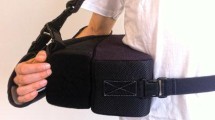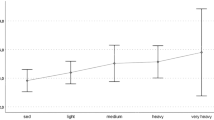Abstract
Purpose
The purpose of this study was to quantify subjective discomfort and decrease in working performance in patients submitted to arthroscopic rotator cuff repair.
Methods
We enrolled 101 asymptomatic administrative employees (mean age 55). Subjects were asked to write a text using Microsoft Word and to make a table using Microsoft Excel, with and without shoulder braces which kept the right shoulder in neutral (brace A) and internal rotation (brace B). Total time needed to complete the tests and number of mistakes committed were annotated. Furthermore, a questionnaire to assess the subjective and interpersonal discomfort caused by the braces was compiled. Data were submitted to statistical analysis.
Results
When any brace is worn, both times and mistakes are higher than those registered without brace (p < 0.02). Both times and mistakes are higher for brace B in comparison with brace A (p < 0.02). Subjects wearing brace B had a severe/very severe discomfort degree three times higher than that registered in subjects wearing brace A. Finally, 91 % of subjects preferred brace A to brace B.
Discussion
If the choice of the brace is not supported by biological or clinical advantages, we recommend to use the brace that keeps the arm at the side, since it ensures better working performance and lower discomfort. It also received the greatest satisfaction of the respondents.
Level of evidence
IV.






Similar content being viewed by others
References
Yamaguchi K, Ditsios K, Middleton WD, Hildebolt CF, Galatz LM, Teefey SA (2006) The demographic and morphological features of rotator cuff disease: a comparison of asymptomatic and symptomatic shoulders. J Bone Jt Surg Am 88:1699–1704
Schibany N, Zehetgruber H, Kainberger F et al (2004) Rotator cuff tears in asymptomatic individuals: a clinical and ultrasonographic screening study. Eur J Radiol 51:263–268
Yamamoto A, Takagishi K, Osawa T et al (2010) Prevalence and risk factors of a rotator cuff tear in the general population. J Shoulder Elbow Surg 219:116–120
Gartsman GM (2003) Shoulder arthroscopy. Elsevier, Philadelphia
Lo IK, Burkhart SS (2004) Transtendon arthroscopic repair of partial-thickness, articular surface tears of the rotator cuff. Arthroscopy 20:214–220
Rockwood CA (1990) The shoulder. Saunders, Philadelphia
Snyder SJ (1993) Shoulder arthroscopy. Lippincott Williams and Wilkins, Philadelphia
Denard PJ, Lädermann A, Burkhart SS (2011) Prevention and management of stiffness after arthroscopic rotator cuff repair: systematic review and implications for rotator cuff healing. Arthroscopy 27:842–848
Parsons BO, Gruson KI, Chen DD, Harrison AK, Gladstone J, Flatow EL (2010) Does slower rehabilitation after arthroscopic rotator cuff repair lead to long-term stiffness? J Shoulder Elbow Surg 19:1034–1039
Itoi E, Hatakeyama Y, Urayama M, Pradhan RL, Kido T, Sato K (1999) Position of immobilization after dislocation of the shoulder. A cadaveric study. J Bone Jt Surg Am 81:385–390
Perugia D, Gumina S, Postacchini F (1996) Immobilization after primary dislocation of the shoulder. J Shoulder Elbow Surg 5:S80
Conflict of interest
S. Gumina, V. Candela, D. Passaretti, L. Mariani, L. Orsina declare that they have no conflict of interest.
Informed consent
All procedures followed were in accordance with the ethical standards of the responsible committee on human experimentation (institutional and national) and with the Helsinki Declaration of 1975, as revised in 2000 (5). All patients provided written informed consent to enrolment in the study and to the inclusion in this article of information that could potentially lead to their identification.
Author information
Authors and Affiliations
Corresponding author
Rights and permissions
About this article
Cite this article
Gumina, S., Candela, V., Passaretti, D. et al. Does immobilization position after arthroscopic rotator cuff repair impact work quality or comfort?. Musculoskelet Surg 98 (Suppl 1), 55–59 (2014). https://doi.org/10.1007/s12306-014-0327-y
Received:
Accepted:
Published:
Issue Date:
DOI: https://doi.org/10.1007/s12306-014-0327-y




